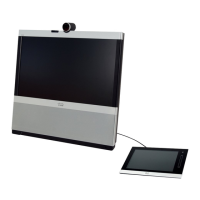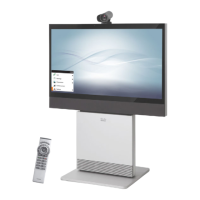36
Cisco TelePresence System EX90/EX60 Administrator guide
D14726.03 Cisco TelePresence System EX90-EX60 Administrator Guide TC4.0, December 2010.
Copyright © 2010 Cisco Systems, Inc. All rights reserved.
www.cisco.com
Advanced conguration
Network [1..1] IEEE8021X Mode
The system can be connected to an IEEE 802.1X LAN network, with a port-based network access
control that is used to provide authenticated network access for Ethernet networks.
Requires user role: ADMIN
Value space: <On/O>
On: The 802.1X authentication is enabled.
O: The 802.1X authentication is disabled (default).
Ex a m ple: Network 1 IEEE8021X Mode: Off
Network [1..1] IEEE8021X AnonymousIdentity
The 802.1X Anonymous ID string is to be used as unencrypted identity with EAP (Extensible
Authentication Protocol) types that support dierent tunneled identity, like EAP-PEAP and EAP-TTLS.
If set, the anonymous ID will be used for the initial (unencrypted) EAP Identity Request.
Requires user role: ADMIN
Value space: <S: 0, 64>
Format: String with a maximum of 64 characters.
Ex a m ple: Network 1 IEEE8021X AnonymousIdentity: ""
Network [1..1] IEEE8021X Identity
The 802.1X Identity is the user name needed for 802.1X authentication.
Requires user role: ADMIN
Value space: <S: 0, 64>
Format: String with a maximum of 64 characters.
Ex a m ple: Network 1 IEEE8021X Identity: ""
Network [1..1] IEEE8021X Password
The 802.1X Password is the password needed for 802.1X authentication.
Requires user role: ADMIN
Value space: <S: 0, 32>
Format: String with a maximum of 32 characters.
Ex a m ple: Network 1 IEEE8021X Password: "***"
Network [1..1] QoS Diserv Signalling
The Diserv Signalling denes which priority Signalling packets should have in an IP network. Enter
a priority, which ranges from 0 to 63 for the packets. The higher the number, the higher the priority.
These priorities might be overridden when packets are leaving the network controlled by the local
network administrator. Note: Requires the Network QoS Mode to be set to Diserv.
Requires user role: ADMIN
Value space: <0..63>
Signalling: A recommended value is Diserv Code Point (DSCP) AF31, which equals the value 26.
If in doubt, contact your network administrator.
Range: Select a value from 0 to 63.
Ex a m ple: Network 1 QoS Diffserv Signalling: 0
Network [1..1] QoS Diserv Video
The Diserv Video denes which priority Video packets should have in an IP network. Enter a priority,
which ranges from 0 to 63 for the packets. The higher the number, the higher the priority. These
priorities might be overridden when packets are leaving the network controlled by the local network
administrator. Note: Requires the Network QoS Mode to be set to Diserv.
Requires user role: ADMIN
Value space: <0..63>
Video: A recommended value is Diserv Code Point (DSCP) AF41, which equals the value 34. If in
doubt, contact your network administrator.
Range: Select a value from 0 to 63.
Ex a m ple: Network 1 QoS Diffserv Video: 0
Network [1..1] DNS Server [1..5] Address
Dene the network addresses for DNS servers. Up to 5 addresses may be specied. If the network
addresses are unknown, contact your administrator or Internet Service Provider.
Requires user role: ADMIN
Value space: <S: 0, 64>
Format: String with a maximum of 64 characters.
Ex a m ple: Network 1 DNS Server 1 Address: ""
Network [1..1] DNS Domain Name
DNS Domain Name is the default domain name sux which is added to unqualied names.
Example: If the DNS Domain Name is "company.com" and the name to lookup is "MyVideoSystem",
this will result in the DNS lookup "MyVideoSystem.company.com".
Requires user role: ADMIN
Value space: <S: 0, 64>
Format: String with a maximum of 64 characters.
Ex a m ple: Network 1 DNS Domain Name: ""
The Network settings, cont... The Network settings, cont...

